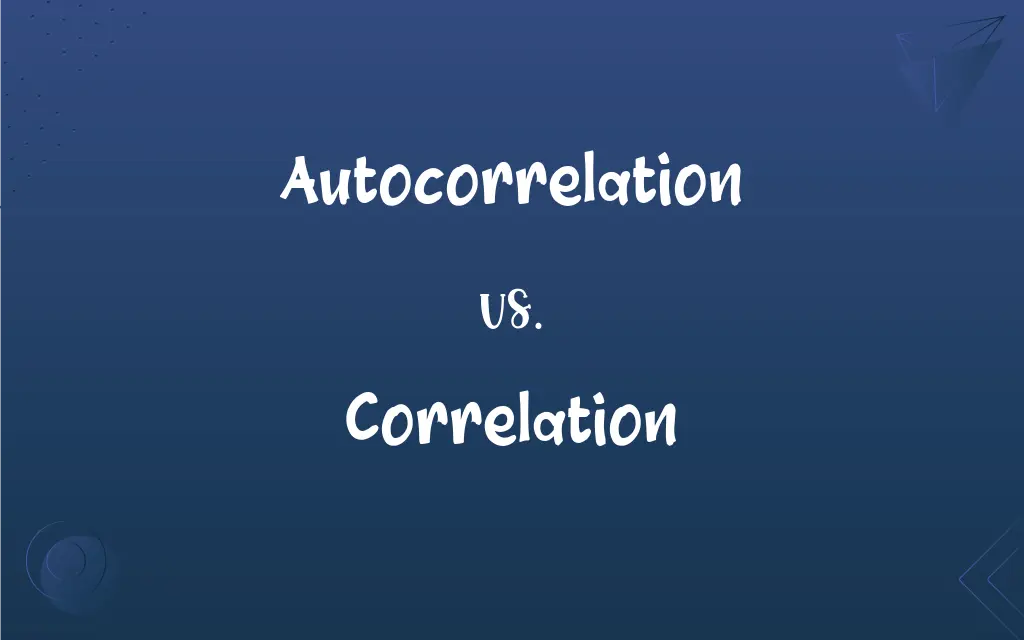Autocorrelation vs. Correlation: What's the Difference?
Edited by Aimie Carlson || By Harlon Moss || Updated on November 11, 2023
Autocorrelation measures the relationship of a variable with itself over intervals, while correlation measures the relationship between two distinct variables.

Key Differences
Autocorrelation refers to the correlation of a signal with a delayed copy of itself as a function of delay. In contrast, correlation assesses the statistical relationship between two different variables, indicating how one variable moves in relation to another.
Autocorrelation is used to find repeating patterns or periodic signals in data sets, such as in time series analysis. Correlation, however, is utilized to determine the degree to which two different variables are linearly related in a data set.
In autocorrelation, the focus is on one variable over different times or positions. Correlation typically involves two variables at the same time point, analyzing how they vary together.
Autocorrelation is crucial in fields like signal processing and time series analysis, identifying the internal relationship within a single dataset. Correlation finds its use in diverse fields like finance, biology, and social sciences, examining relationships between different datasets.
High autocorrelation can indicate a non-random pattern in a time series. In correlation, a high value implies a strong relationship between two distinct variables.
ADVERTISEMENT
Comparison Chart
Definition
Measures how a variable correlates with itself over intervals
Measures the relationship between two different variables
Primary Use
Identifying patterns in the same dataset over time
Assessing the degree of linear relationship between datasets
Typical Applications
Signal processing, time series analysis
Diverse fields like finance, biology, social sciences
Focus
One variable across different times or positions
Two variables at a single time point
Implication of Values
High value indicates repeated patterns within a dataset
High value implies a strong linear relationship between datasets
ADVERTISEMENT
Autocorrelation and Correlation Definitions
Autocorrelation
Autocorrelation measures how much past values in a time series predict future values.
High autocorrelation in stock prices suggests predictability based on past trends.
Correlation
Correlation can be positive, negative, or zero, indicating different types of relationships.
A negative correlation was observed between smoking and lung capacity.
Autocorrelation
Autocorrelation identifies the degree of similarity between a time series and a lagged version of itself.
The autocorrelation function showed significant similarity at specific lags in the signal.
Correlation
Correlation measures the strength and direction of a linear relationship between two variables.
There was a strong positive correlation between exercise frequency and health outcomes.
Autocorrelation
Autocorrelation helps in understanding the internal structure of a dataset.
Autocorrelation was crucial in analyzing the repeating patterns in the climatic data.
Correlation
Correlation is used to predict one variable based on another.
Correlation analysis was used to predict sales based on advertising spend.
Autocorrelation
Autocorrelation is used to detect non-randomness in data.
The autocorrelation test indicated non-random behavior in the monthly sales data.
Correlation
Correlation does not imply causation but indicates association.
While a correlation between diet and mood was found, causation cannot be inferred.
Autocorrelation
Autocorrelation is the correlation of a signal with itself over various time lags.
The autocorrelation analysis revealed seasonal patterns in the temperature data.
Correlation
Correlation quantifies how one variable changes in relation to another.
The study found a high correlation between hours of study and exam scores.
Autocorrelation
The cross-correlation of a signal with itself: the correlation between values of a signal in successive time periods.
Correlation
A relationship or connection between two things based on co-occurrence or pattern of change
A correlation between drug abuse and crime.
Correlation
(Statistics) The tendency for two values or variables to change together, in either the same or opposite way
As cigarette smoking increases, so does the incidence of lung cancer, indicating a positive correlation.
Correlation
An act of correlating or the condition of being correlated.
Correlation
A reciprocal, parallel or complementary relationship between two or more comparable objects.
Correlation
(statistics) One of the several measures of the linear statistical relationship between two random variables, indicating both the strength and direction of the relationship.
Correlation
(algebra) An isomorphism from a projective space to the dual of a projective space, often to the dual of itself.
Correlation
Reciprocal relation; corresponding similarity or parallelism of relation or law; capacity of being converted into, or of giving place to, one another, under certain conditions; as, the correlation of forces, or of zymotic diseases.
Correlation
A reciprocal relation between two or more things
Correlation
A statistic representing how closely two variables co-vary; it can vary from -1 (perfect negative correlation) through 0 (no correlation) to +1 (perfect positive correlation);
What is the correlation between those two variables?
Correlation
A statistical relation between two or more variables such that systematic changes in the value of one variable are accompanied by systematic changes in the other
FAQs
What does a high autocorrelation value mean?
It suggests a strong relationship between past and future values in the same series.
Why is autocorrelation important in time series analysis?
It helps identify patterns and predict future values in the series.
What is correlation?
Correlation is a statistical measure that describes the extent to which two variables change together.
How is correlation different in direction?
Correlation can be positive (variables increase together), negative (one increases, the other decreases), or zero (no relationship).
Is autocorrelation always positive?
No, it can be positive, negative, or zero, depending on the data.
What tools measure autocorrelation?
Autocorrelation functions or ACF plots in statistical software.
Can correlation indicate causation?
No, correlation indicates association, not causation.
How does sample size affect autocorrelation?
Larger samples can provide more reliable autocorrelation estimates.
What is autocorrelation?
Autocorrelation is the correlation of a variable with itself over different intervals.
What causes autocorrelation in data?
Patterns, trends, or cyclical movements in time series data.
Is a correlation of 0 meaningful?
Yes, it indicates no linear relationship between the variables.
Can autocorrelation lead to false conclusions?
Yes, especially if it’s mistaken for causality or not accounted for in models.
Where is correlation commonly used?
In research, finance, health sciences, and more to assess relationships between variables.
Are correlation coefficients always between -1 and +1?
Yes, correlation coefficients range from -1 to +1.
Can two unrelated variables show correlation?
Yes, due to chance or a third, confounding variable.
What is the danger of ignoring autocorrelation in analysis?
It can lead to inaccurate predictions and misunderstanding of the data structure.
Does high correlation mean high accuracy?
Not necessarily, as it only measures the strength of a linear relationship, not accuracy.
Can correlation be used for prediction?
Yes, but with caution as it doesn’t confirm causality.
What is a perfect correlation?
A correlation coefficient of +1 or -1, indicating a perfect linear relationship.
What is lag in autocorrelation?
The time interval between compared points in a time series.
About Author
Written by
Harlon MossHarlon is a seasoned quality moderator and accomplished content writer for Difference Wiki. An alumnus of the prestigious University of California, he earned his degree in Computer Science. Leveraging his academic background, Harlon brings a meticulous and informed perspective to his work, ensuring content accuracy and excellence.
Edited by
Aimie CarlsonAimie Carlson, holding a master's degree in English literature, is a fervent English language enthusiast. She lends her writing talents to Difference Wiki, a prominent website that specializes in comparisons, offering readers insightful analyses that both captivate and inform.
































































